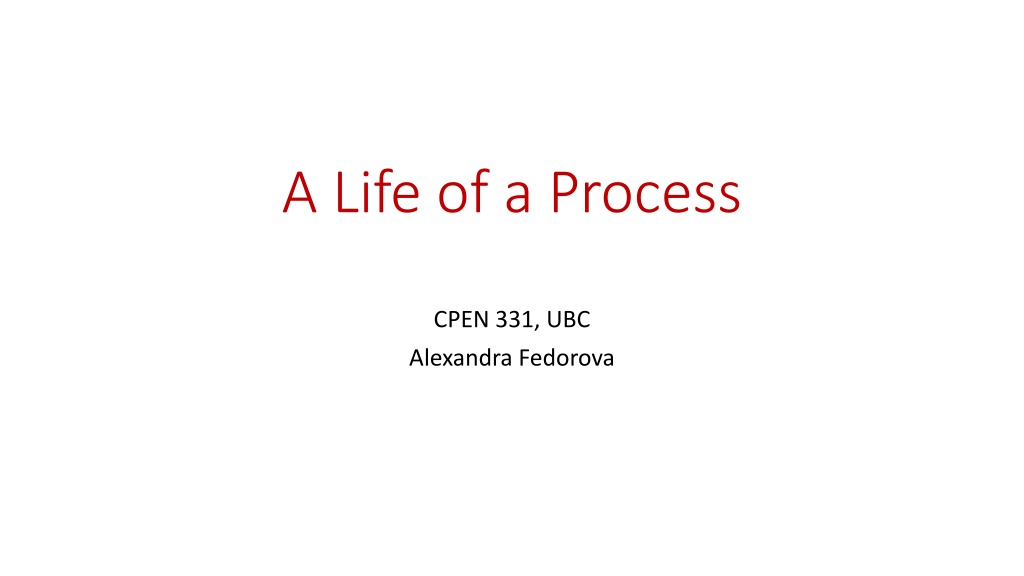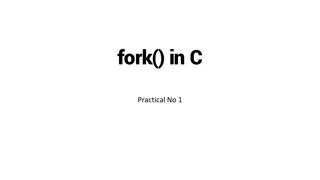A Life of a Process
This content delves into the creation and management of processes in operating systems, covering concepts such as forking processes, process states, address space management, copying processes, and key functions involved in process handling. It provides insights on constructing processes from scratch, copying existing processes, and the components that make up a process state. Additionally, it highlights the importance of addressing space, architectural state, file tables, and kernel threads in process management within the operating system environment.
Download Presentation

Please find below an Image/Link to download the presentation.
The content on the website is provided AS IS for your information and personal use only. It may not be sold, licensed, or shared on other websites without obtaining consent from the author.If you encounter any issues during the download, it is possible that the publisher has removed the file from their server.
You are allowed to download the files provided on this website for personal or commercial use, subject to the condition that they are used lawfully. All files are the property of their respective owners.
The content on the website is provided AS IS for your information and personal use only. It may not be sold, licensed, or shared on other websites without obtaining consent from the author.
E N D
Presentation Transcript
A Life of a Process CPEN 331, UBC Alexandra Fedorova
How do you create a process in operating How do you create a process in operating systems (in general)? systems (in general)? A. You construct it from scratch, using the program binary and building up the needed memory structures. B. You create a copy of an existing process C. All of the above
Today: Fork: Copying a process Today: Fork: Copying a process Review the different parts of the process Understand how they are constructed. Understand how to copy them.
Fork: the concept Fork: the concept PROCESS pid: 13 addrspace: 0x5678 FDs Fobj ptr 0 COPY 1 NEW PROCESS 2 3 0x1234 4 Arch state
What comprises a process state? What comprises a process state? 1. Address space 2. Threads 3. Architectural state 4. File table 5. A kernel thread that gets assigned to a process when the process traps into the kernel
End goal: 1. 2. 3. 4. 5. Copy address space Copy file table Copy architectural state Copy kernel thread Return to user mode Fork: the guts Fork: the guts Child process Parent process Address space Architectural state User Kernel 1. Call fork() system call and trap into the kernel 4. Invoke sys_fork: 3. Save architectural state OS161: struct trapframe in exception-mips1.S 2. Gets a kernel stack and a kernel thread OS161: common_exception in exception-mips1.S trapframe Kernel thread File table You write this time
Address Space Address Space Where do these pieces come from? Defined at a pre-determined virtual address In os161: as_define_stack() User-level allocator (e.g., malloc) asks to extend the address space. In os161 (and Unix): sbrk() Directly from the executable In os161: load_elf()
Copying the address space Copying the address space ADDRESS SPACES MUST END UP IDENTICAL
Code Code- -reading Exercises reading Exercises Read the code in kern/arch/mips/vm/dumbvm.cand in the related include files. What data structure does os161 use to keep track of the different parts of the address space? A. vaddr_t B. vbase1 vbase2, stackbase, vtop C. struct addrspace D. struct vnode E. struct uio
Code Code- -reading Exercises reading Exercises Read the code in kern/arch/mips/vm/dumbvm.c. Which function helps you create a copy of an address space? A. load_elf B. VOP_READ C. as_activate D. as_copy E. None of the above
End goal: 1. 2. 3. 4. 5. Copy address space Copy file table Copy architectural state Copy kernel thread Return to user mode Fork: the guts Fork: the guts Child process Parent process Address space Address space Architectural state User Kernel 1. Call fork() system call and trap into the kernel 4. Invoke sys_fork: 1. Copy address space 3. Save architectural state OS161: struct trapframe in exception-mips1.S 2. Gets a kernel stack and a kernel thread OS161: common_exception in exception-mips1.S trapframe Kernel thread File table You write this time
File Tables: part copied / part shared File Tables: part copied / part shared file /foo pid: 13 addrspace: 0x5678 pid: 14 addrspace: 0x789a vnode ptr mode flags FDs Fobj ptr FDs Fobj ptr offset 0 0 1 1 2 2 3 0x1234 3 0x1234 4 4 When a process is forked, file descriptor entries of the new process point to the same file objects as in the parent process. We will see later why things are done this way. File File Object Pointers If the parent changes the offset of a file, the child sees that change, and vice versa descriptors You write the code to copy your file table.
End goal: 1. 2. 3. 4. 5. Copy address space Copy file table Copy architectural state Copy kernel thread Return to user mode Fork: the guts Fork: the guts Child process Parent process Address space Address space Architectural state User Kernel 1. Call fork() system call and trap into the kernel 4. Invoke sys_fork: 1. Copy address space 2. Copy file table 3. Save architectural state OS161: struct trapframe in exception-mips1.S 2. Gets a kernel stack and a kernel thread OS161: common_exception in exception-mips1.S trapframe Kernel thread File table File table You write this time
Architectural State Architectural State Registers, including %pc, %sp. Why do you need to save this stuff? Let s review the semantics of fork() to understand what we need to do with the architectural state.
Example: forking a new process Example: forking a new process Download the code from: http://people.ece.ubc.ca/os161/download/LECTURES-CODE/fork.c
Architectural state: almost identical Architectural state: almost identical Return to the same location, DIFFERENT return values; CHILD PARENT Child gets zero Parent gets a child PID Stack pointer: same or not? A. Same B. Not the same Program counter: same of not? A. Same B. Not the same Registers: same or not? A. Same B. Not the same
In OS161, where is the architectural state saved In OS161, where is the architectural state saved once we trap into the kernel and once we are done once we trap into the kernel and once we are done with the code in exception with the code in exception- -mips1.S? mips1.S? A. In registers B. In struct trapframe C. In the process struct
So how do you copy architectural state? So how do you copy architectural state?
Code reading exercise Code reading exercise Review the system call dispatch code in os161. What register would be different between the parent and the child as they both return to usermode from an exception? A. %sp B. %pc C. %v0 D. %a3 E. %v0 and %a3 In your implementation of A5, you will have to make sure the right value is returned to the right process.
End goal: 1. 2. 3. 4. 5. Copy address space Copy file table Copy architectural state Copy kernel thread Return to user mode Fork: the guts Fork: the guts Child process Parent process Address space Address space Architectural state User Kernel 1. Call fork() system call and trap into the kernel 4. Invoke sys_fork: 1. Copy address space 2. Copy file table 3. Copy and tweak trapframe 3. Save architectural state OS161: struct trapframe in exception-mips1.S 2. Gets a kernel stack and a kernel thread OS161: common_exception in exception-mips1.S trapframe Kernel thread File table trapframe File table You write this time
End goal: 1. 2. 3. 4. 5. Copy address space Copy file table Copy architectural state Copy kernel thread Return to user mode Fork: the guts Fork: the guts Child process Parent process Address space Address space Architectural state User Kernel 1. Call fork() system call and trap into the kernel 4. Invoke sys_fork: 1. Copy address space 2. Copy file table 3. Copy and tweak trapframe 4. Copy kernel thread 3. Save architectural state OS161: struct trapframe in exception-mips1.S 2. Gets a kernel stack and a kernel thread OS161: common_exception in exception-mips1.S Kernel thread trapframe Kernel thread File table thread_fork() trapframe File table You write this time
When you fork a new process, you fork a new kernel When you fork a new process, you fork a new kernel thread to provide to the child process. To fork that thread to provide to the child process. To fork that thread, you need to provide it a function to run. thread, you need to provide it a function to run. You ll need to write that function. You ll need to write that function. What do you think that function should do? What do you think that function should do?
How does the child process get to run in user How does the child process get to run in user mode for the very first time? (Hints) mode for the very first time? (Hints) Think about how the parent process returns to user mode after executing the system call. Read the code and find out how the user process constructed by os161 gets to run in user mode e.g., when you ask it to run a user program in a menu, such as p /testbin/badcall Can you figure out how to make the new child process run in user mode?
End goal: 1. 2. 3. 4. 5. Copy address space Copy file table Copy architectural state Copy kernel thread Return to user mode Fork: the guts Fork: the guts Child process Parent process Address space Address space The parent just returns from exception. The child returns via the usermode function. Architectural state User Kernel 1. Call fork() system call and trap into the kernel 6. Both parent and child return to user mode. 4. Invoke sys_fork: 1. Copy address space 2. Copy file table 3. Copy and tweak trapframe 4. Copy kernel thread 5. Return to user mode 3. Save architectural state OS161: struct trapframe in exception-mips1.S 2. Gets a kernel stack and a kernel thread OS161: common_exception in exception-mips1.S Kernel thread trapframe Kernel thread File table thread_fork() 5. New thread calls a function that will take it to user mode trapframe File table You write this time
File Tables: part copied / part shared File Tables: part copied / part shared file /foo pid: 13 addrspace: 0x5678 pid: 14 addrspace: 0x789a vnode ptr mode flags FDs Fobj ptr FDs Fobj ptr offset 0 0 1 1 2 2 3 0x1234 3 0x1234 4 4 When a process is forked, file descriptor entries of the new process point to the same file objects as in the parent process. We will see later why things are done this way. File File Object Pointers If the parent changes the offset of a file, the child sees that change, and vise versa descriptors
Why share file descriptors? Why share file descriptors? First, let s look at a few simple examples to understand the effects of shared file objects From the directory http://people.ece.ubc.ca/~os161/download/LECTURES-CODE download the following files: pipes.c pipes2.c
The mechanics of pipes ( The mechanics of pipes (pipe.c pipe.c) ) Parent process Child process vnodes pid: 13 addrspace: 0x5678 pid: 14 addrspace: 0x789A A special pipe file FDs Fobj ptr FDs Fobj ptr (just a memory buffer) 0 0 for reading 1 1 for reading 2 2 3 0x1234 3 0x1234 for writing 4 0x4567 4 0x4567 for writing Step 2: A child is forked It shares file handles with the parent; can read/write the same pipe. Step 1: A special pipe file is created in memory Two file descriptors refer to its vnode: one for reading, one for writing
Redirecting Pipe I/O via dup2 (pipes2.c) Redirecting Pipe I/O via dup2 (pipes2.c) Parent process Child process vnodes pid: 13 addrspace: 0x5678 pid: 14 addrspace: 0x789A A special pipe file FDs Fobj ptr FDs Fobj ptr (just a memory buffer) 0 0 1 0x4567 1 2 2 3 0x1234 3 0x1234 4 0x4567 4 0x4567 Step 1: Parent closes the descriptor associated with the unused end of the pipe (pfd[0]) Step 2: Parent redirects output end of the pipe (pfd[1]) to STDOUT via the dup2 system call. Outcome: Whatever the parent is writing to STDOUT Can be read by the child from the pipe
A more interesting use case A more interesting use case Suppose you wanted to do something like this: % cat log-file.txt | grep error From the directory http://people.ece.ubc.ca/~os161/download/LECTURES-CODE download the following files: pipes-exec.c
file /foo pid: 13 addrspace: 0x5678 pid: 14 addrspace: 0x789a vnode ptr mode flags FDs Fobj ptr FDs Fobj ptr offset 0 0 1 1 2 2 3 0x1234 3 0x1234 4 4 When a process is forked, file descriptor entries of the new process point to the same file objects as in the parent process. Why not share the entire file table including the file descriptors? File File Object Pointers descriptors
file /foo pid: 13 addrspace: 0x5678 pid: 14 addrspace: 0x789a vnode ptr mode flags FDs Fobj ptr FDs Fobj ptr offset 0 0 1 1 2 2 3 0x1234 3 0x1234 4 4 0x5432 file /foo vnode ptr mode flags File File Object Pointers offset descriptors If process 14 opens a file via an open() system call, it will get a separate file object. The parent DOES NOT see that file object
file /foo pid: 13 addrspace: 0x5678 pid: 14 addrspace: 0x789a vnode ptr mode flags FDs Fobj ptr FDs Fobj ptr offset 0 0 1 1 2 2 3 0x1234 3 0x1234 4 4 0x5432 file /foo vnode ptr mode flags File File Object Pointers offset descriptors If process 14 closes a file, that file is NOT closed in the parent.
Rules of file descriptor sharing Rules of file descriptor sharing Files opened after fork() do not share file objects with the parent/child. Files closed after fork() only free the descriptor in the process that closed it
file /foo pid: 13 addrspace: 0x5678 pid: 14 addrspace: 0x789a vnode ptr mode flags FDs Fobj ptr FDs Fobj ptr offset 0 0 1 1 2 2 3 0x1234 3 0x1234 4 4 What kind of race conditions do you have to worry about? File File Object Pointers descriptors
























